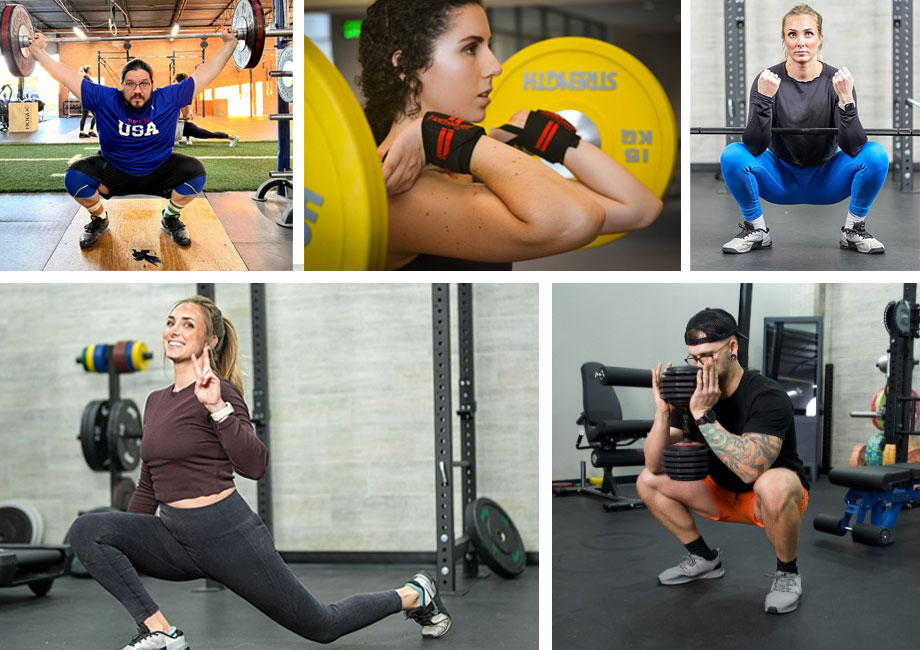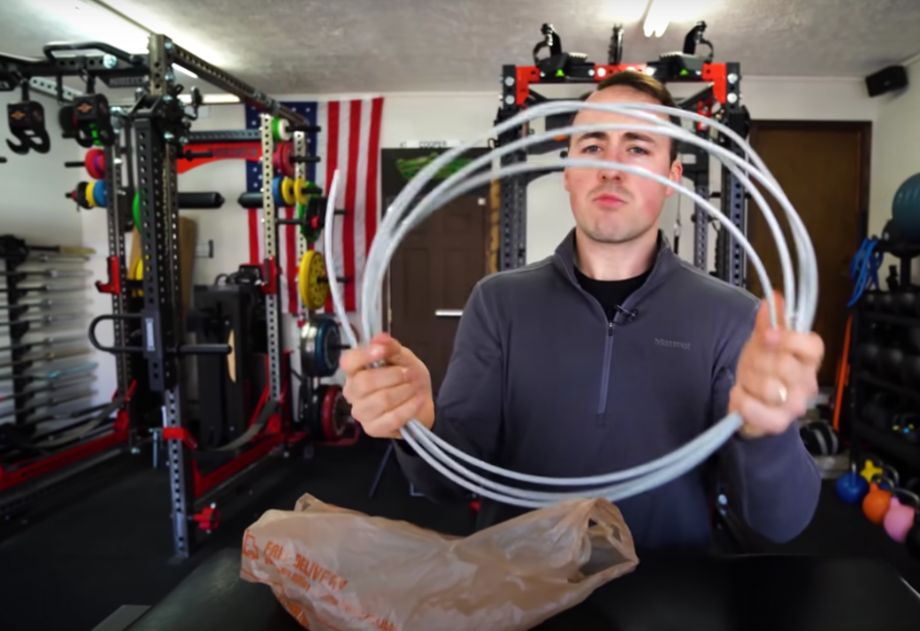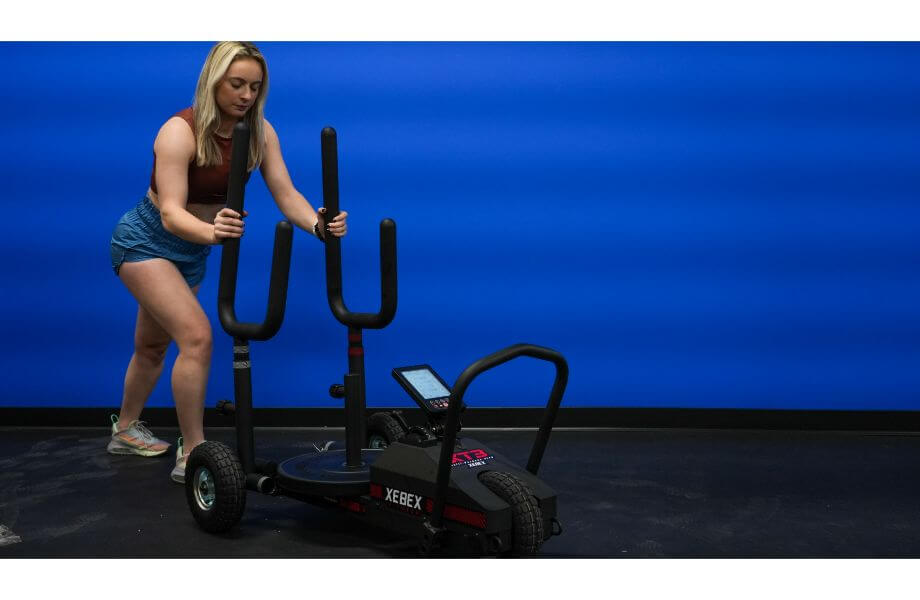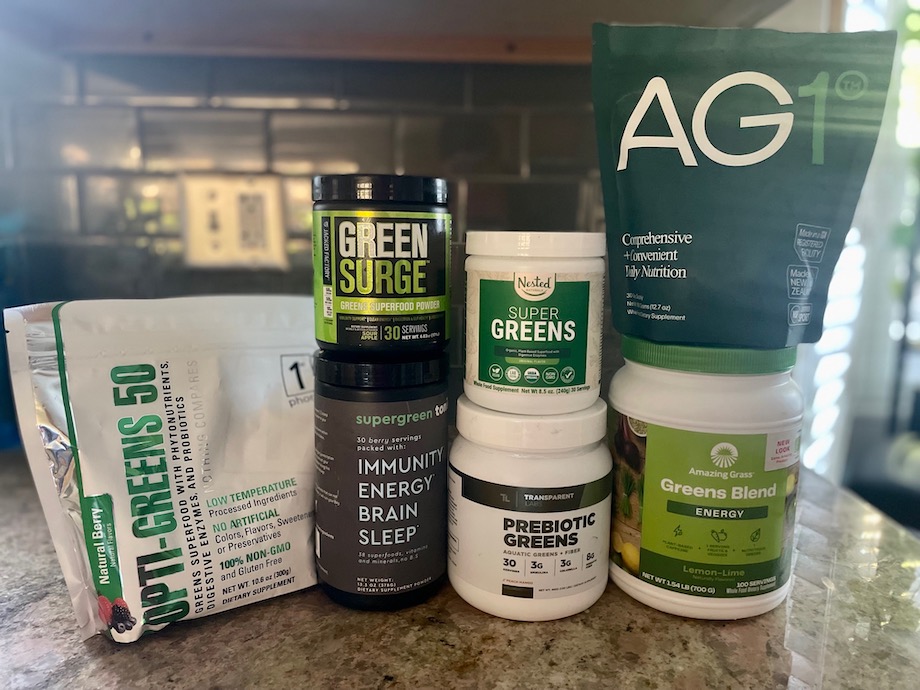There’s a reason why back squats are one of—if not the—most performed exercises. They hit all of your lower-body muscles and the core, improve your mobility, burn calories, and even boost your hormone production naturally (as found in this 2018 Neuro Endocrinology Letters1 randomized controlled trial).
However, barbell squats aren’t the only way to get those benefits. There are plenty of squat variations that do a similar job. Some are less intimidating for beginners, and others may be easier on your knees and lower back compared to back squats. When equipment is limited, it’s helpful to have a variety of squat variations in your training repertoire.
I—a certified personal trainer (CPT)—aim to describe how to do the different squats step by step so you can maintain proper form. I’ll then share three squat variations workouts. I’ve been doing these exercises for the past 10 years, so rest assured you’re in safe hands. Let’s begin!
21 Best Squat Variations
- Bodyweight Squat
- Wall Squat
- Pause Squat
- Band Squat
- Split Squat
- Bulgarian Split Squat
- Front Squat
- Goblet Squat
- Plie Squat
- Box Squat
- Sissy Squat
- Overhead Squat
- Zercher Squat
- Pistol Squat
- Jump Squat
- Cossack Squat
- Hack Squat
- Landmine Squat
- Smith Machine Squat
- Anderson Squat
- Chair Squat
Bodyweight Squat
Benefits: Those new to strength training can learn bodyweight squats before attempting back squats or any other squat variation. Even if you’re an experienced gym-goer, you can add bodyweight squats to your warm-up routine. Because this squat exercise doesn’t require equipment, you can do it anywhere.
How to do it:
- Stand tall with your feet shoulder-width apart.
- Position your arms by your sides, in front of you, or across your chest.
- Brace your core and squeeze your glutes.
- Squat down, similar to if you were sitting on a chair.
- Keep going until your quads are at least parallel to the floor. Pause momentarily.
- Return to the standing position by pushing your heels into the ground.
- Continue for the desired number of repetitions.
RELATED: Best Warm-Up Exercises
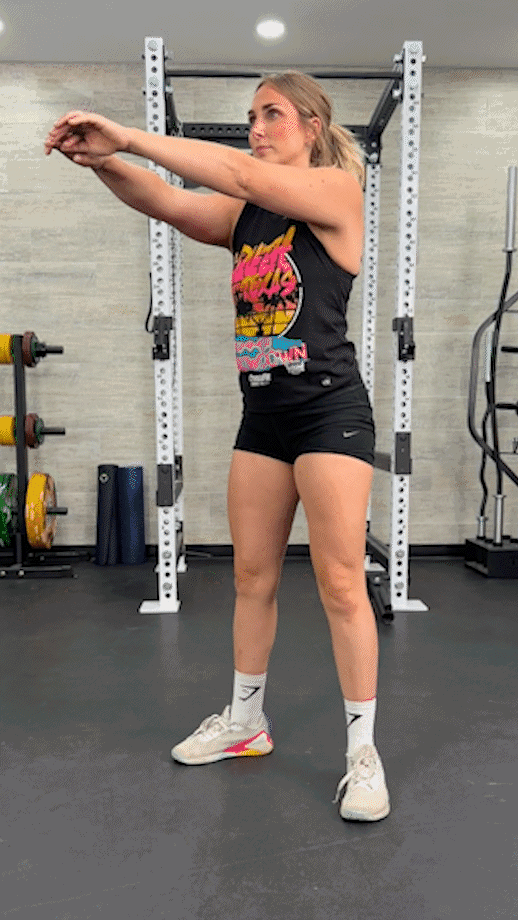
Wall Squat
Benefits: Wall squats—aka the wall sit exercise—can also be done anywhere. You can easily progress the exercise by increasing the duration or placing a dumbbell, kettlebell, weight plate, or other equipment on your lap. If you experience lower back pain during back squats, consider adding wall squats to your next leg day workout.
How to do it:
- Stand against a wall. The back of your head, upper back, and butt should be touching it.
- Position your arms by your sides and ensure your feet are shoulder-width apart.
- Step your feet forward one or two steps, then tense your core.
- Slide down the wall until your quadriceps are parallel to the floor. The back of your body should stay in contact with the wall.
- Hold this position for the desired duration of time.
- Reverse the motion by sliding up the wall.
- Repeat as required.
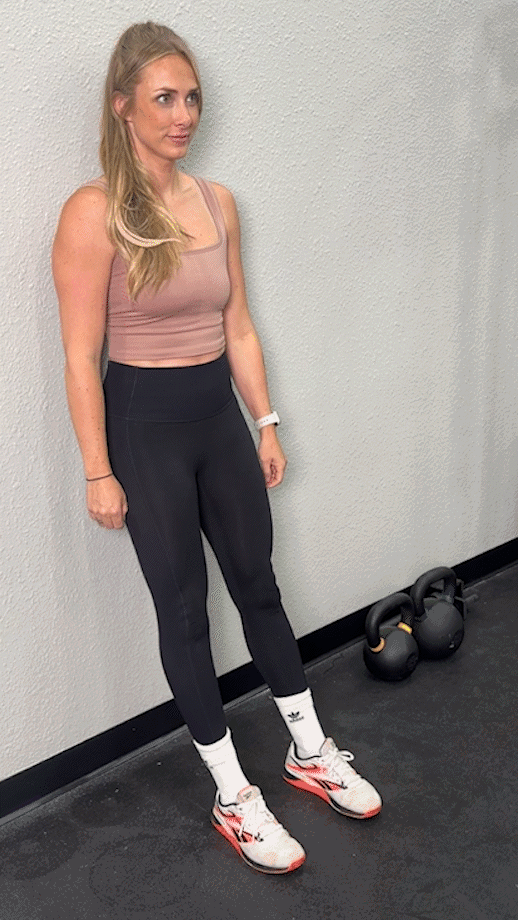
Pause Squat
Benefits: A 2018 European Journal of Applied Physiology2 study found that pause squats may be better than traditional squats for muscular hypertrophy. Therefore, if building size in your leg muscles is your primary goal, pause squats are a fantastic squat variation to learn. Compared to regular squats, pause squats require more balance and explosiveness.
How to do it:
- Adjust the J-hooks on a squat or power rack so the barbell is at shoulder height, then add your desired weight.
- Step underneath the bar with your feet hip-width apart. You’ll want to hold the bar with your hands as close to your shoulders as possible (while still being comfortable).
- Engage your core, and then unrack the bar.
- Step backward one or two steps, adjusting your feet if necessary.
- Squat down until your thighs are at least parallel to the ground. Pause for two or three seconds.
- Push through your feet to return to the starting position.
- Keep going for reps. Rerack the barbell when you’re finished.
Expert tip: Although I’ve described how to do a pause squat with a barbell, you can also do them with a dumbbell or kettlebell. This exercise is called pause goblet squats, and you’ll learn the goblet squat movement pattern below.
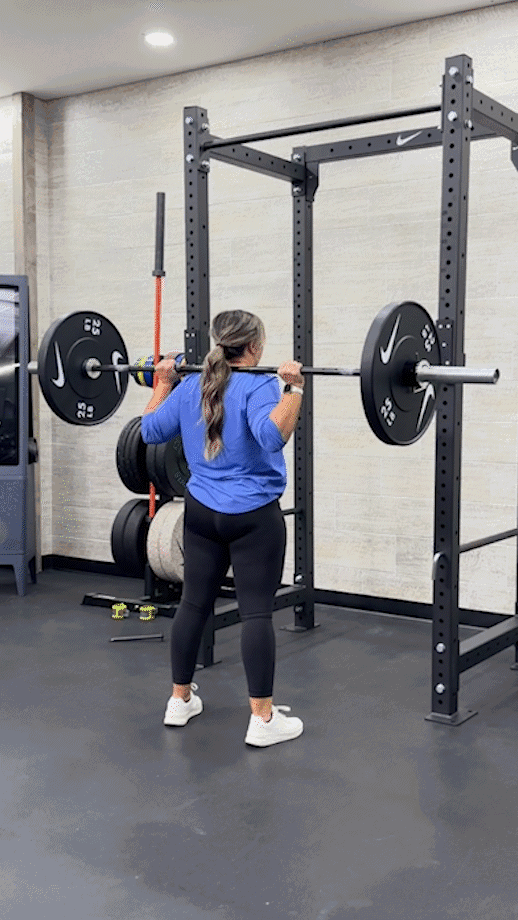
Band Squat
Benefits: The benefits of doing squats with resistance bands are plenty. They’re more challenging than bodyweight squats (which you saw above) but aren’t as intimidating as barbell squats for beginners. Resistance bands are portable, versatile, and relatively inexpensive compared to free weights.
How to do it:
- Stand upright with your feet shoulder-width apart.
- Place both feet on top of one end of a resistance band.
- Loop the other end of the resistance band over your head and place it at the back of your neck.
- Squeeze your glutes and brace your core.
- Bend at the hips and knees to squat down. Continue until your quads are at least parallel to the ground, if not deeper.
- Push against the resistance of the band to stand up.
- Repeat for reps.
RELATED: Best Resistance Bands
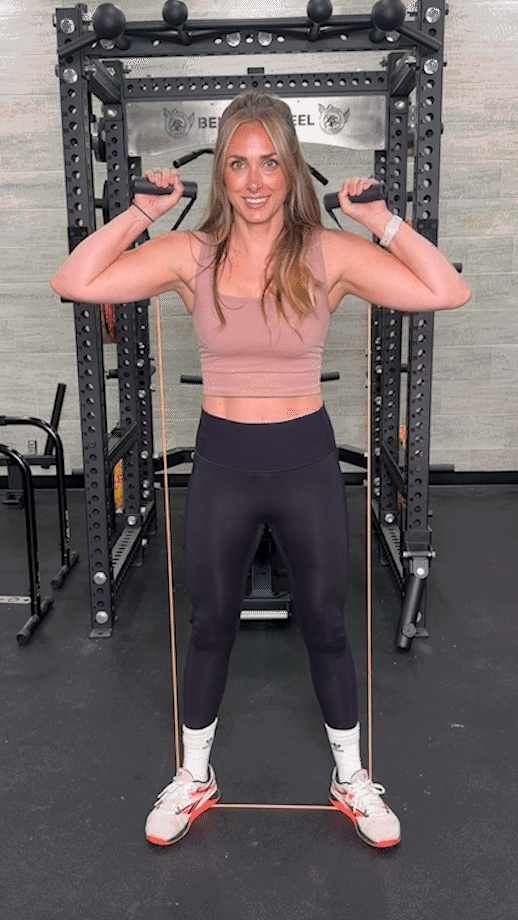
Split Squat
Benefits: Because you work one side at a time, split squats can help fix muscular imbalances and address bilateral deficits3, which you won’t get with regular squats. You’ll improve your balance and coordination, and they’re challenging with just your body weight.
How to do it:
- Stand tall with your feet hip-width apart and your arms by your sides.
- Lift your left foot off the ground, and step back to enter the split stance position. Your left toes should be on the ground, and your right foot should stay fixed in place.
- Bend your right knee to move toward the ground. You’ll want to keep your chest up and your core tensed.
- Keep going until your knees form 90-degree angles, then pause.
- Push your right heel into the ground to return to the split stance position.
- Repeat for reps.
- Repeat the exercise on the other side.
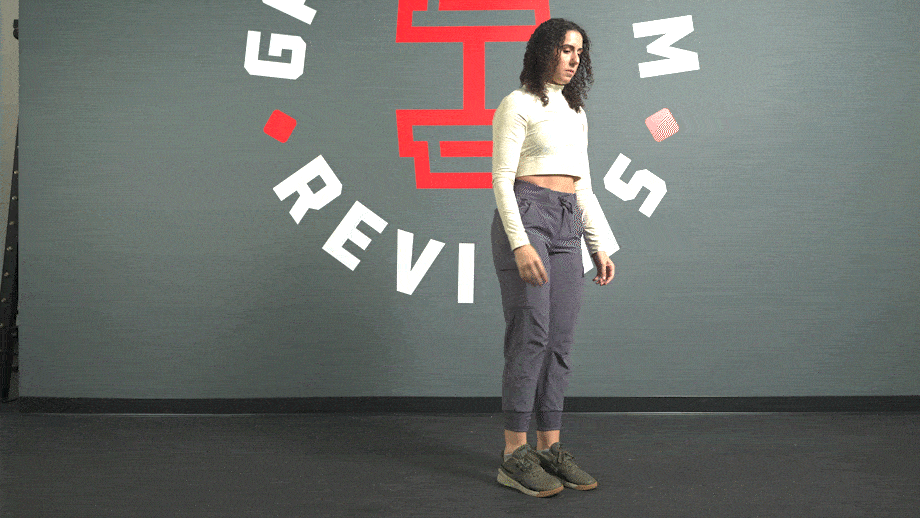
Bulgarian Split Squat
Benefits: Bulgarian split squats are one of my favorite types of squats. Similar to the split squats above, they correct muscular imbalances on either side of the body. However, they’re more difficult than split squats because you elevate your rear leg, leading to increased muscle activation and an added balance challenge.
How to do it:
- Place a flat bench, plyometric box, or a similar sturdy object with a flat surface on the floor.
- Stand tall in front of the equipment, facing away from it.
- Place the upper half of your left foot on the elevated surface. Your right foot should remain fixed on the floor.
- Engage your core, lift your chest up, and bend your right knee to lower yourself.
- Pause momentarily when your right thigh is parallel to the ground.
- Drive through your right foot to return to the original position.
- Continue for reps before switching to the opposite side.
Expert tip: Hold a dumbbell in each hand to take your Bulgarian split squats to the next level. Alternatively, you can use a barbell by placing a sturdy object behind one of the best squat racks.
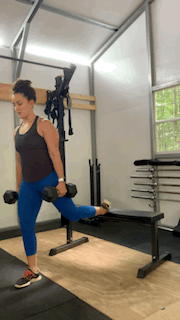
Front Squat
Benefits: Front squats and back squats are both compound exercises, working multiple muscle groups. However, a 2009 Journal of Strength and Conditioning Research4 comparative study found that front squats “May be advantageous compared with back squats for individuals with knee problems such as meniscus tears, and for long-term joint health.”
How to do it:
- Adjust the J-hooks on a squat or power rack so the bar is at shoulder height, then add the necessary weight plates.
- Step underneath the bar with your feet hip-width apart. You’ll want the bar to be resting on your upper chest, and you should hold it with your palms facing the ceiling.
- Unrack the bar, then take one or two steps backward.
- Brace your core, squeeze your glutes, and keep your elbows high.
- Squat down to at least parallel, ensuring your heels remain fixed to the floor.
- Reverse the motion to return to the standing position.
- Repeat for reps before reracking the bar.
RELATED: Front Squat Vs Back Squat
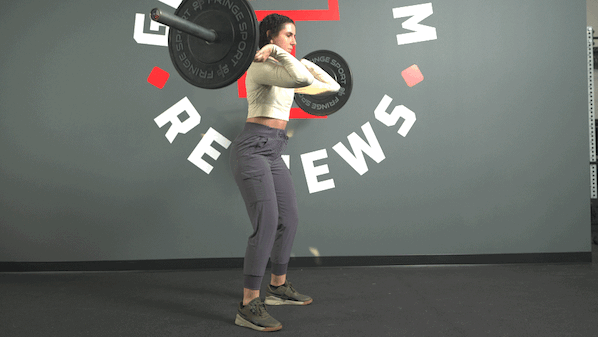
Goblet Squat
Benefits: Goblet squats are easier to perform than barbell squats because you don’t need to unrack and rerack a barbell from a squat or power rack. The other benefit is that holding a single dumbbell or kettlebell in both hands engages your total body, including your upper back, arms, shoulders, and legs (of course).
How to do it:
- Stand upright, holding either a single dumbbell or kettlebell in both hands in front of your chest. You’ll want your feet to be hip-width apart.
- Engage your core and keep your head neutral.
- Squat down as though you were sitting on a chair.
- Pause when your quadriceps are at least parallel to the ground, if not deeper.
- Push through both feet to stand back up.
- Repeat for the desired number of reps.
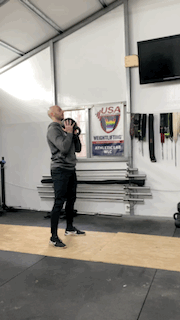
Plie Squat
Benefits: With plie squats (or sumo squats), you activate your inner thighs more than you would with regular squats (why we included plie squats in our list of best adductor exercises). I wouldn’t recommend replacing back squats with plie squats completely, you can include both weightlifting exercises in your training regimen.
How to do it:
- Stand tall with your feet wider than hip-width apart. Your toes should be pointing outwards at roughly 45-degree angles.
- Position your arms by your sides, in front of you, or across your chest. Alternatively, place your hands on your hips.
- Squeeze your glutes and activate your core, then bend at your hips and knees to squat down.
- Keep lowering until your thighs are at least parallel to the floor. Hold momentarily.
- Drive your heels into the ground to return to the standing position.
- Continue for reps.
Expert tip: Hold a single dumbbell or kettlebell in both hands to make plie squats more challenging. Instead of the equipment being in front of your chest—as you saw with the goblet squats above—position it at your pelvic region and squat down so the equipment nearly touches the floor.
RELATED: Best Dumbbells
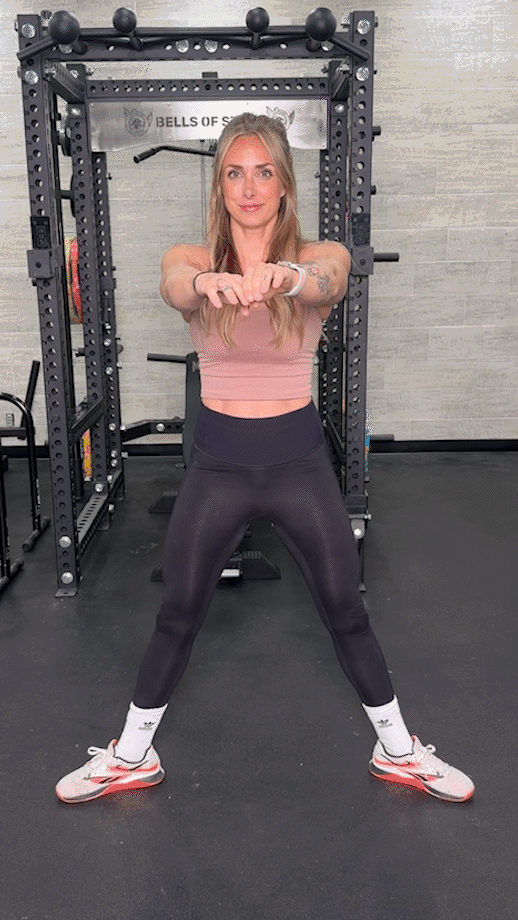
Box Squat
Benefits: With box squats, your range of motion (ROM) is shorter, meaning you may be able to load heavier weights to the bar, and the risk of injury is lower. If you find yourself at a plateau on back squats, consider doing box squats for a short while.
How to do it:
- Place one of the best plyo boxes behind a squat rack. You can use a flat bench or a similar sturdy object if you don’t have one.
- Unrack a loaded bar, similar to how you would with a barbell back squat.
- Step backward to get closer to the box, adjusting your feet if necessary.
- Brace your core, squeeze your glutes, and keep your head neutral.
- Squat down until you sit on the plyometric box.
- Pause before exploding upward back to the starting position.
- Keep going for reps. Rerack the bar when you’re done.
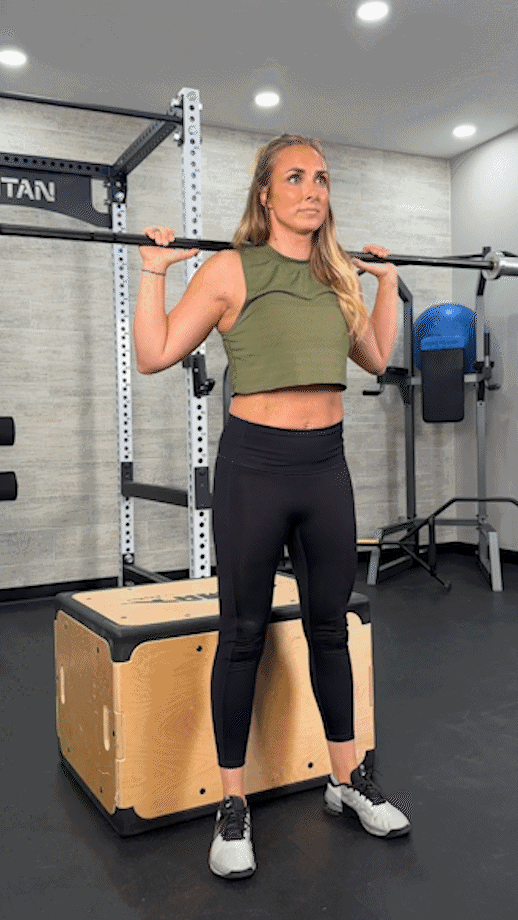
Sissy Squat
Benefits: Despite the name, sissy squats are one of the best exercises that can do sans equipment to work your lower body. I’ve been training for 10 years, and I still find sissy squats challenging. You’ll activate the same muscle groups as regular squats, and consistently doing this exercise is guaranteed to set your quads on fire.
How to do it:
- Stand with your feet shoulder-width apart and your heels raised. You can use a weight plate or a pair of dumbbells to elevate your feet.
- Hold a squat rack, Smith machine, or a similar sturdy object with one hand to help with stability. The other hand can be at your side or placed across your chest.
- Bend your knees slightly and engage your core.
- Push your knees forward while simultaneously leaning backward. You’ll begin lowering yourself toward the floor.
- Pause when you can’t lower any further.
- Drive through the front of your feet to return to the original position.
- Repeat for reps.
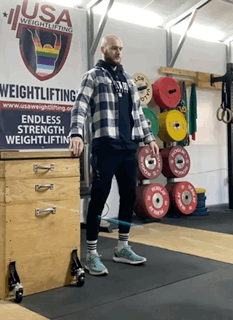
Overhead Squat
Benefits: Overhead squats are a popular CrossFit exercise. Although you’ll need to reduce the load on the bar compared to traditional squats, you’ll improve your shoulder and core mobility as you move. Plus, unlike back squats, you’ll hit the majority of the muscles in your upper body, including your shoulders, arms, and back.
How to do it:
- Unrack a loaded barbell from a squat or power rack, similar to how you would with a back squat.
- Step backward one or two steps, adjusting your feet to be hip-width apart.
- Slide your hands out across the bar. You’ll want them to be close to the weight plates while remaining comfortable.
- Squeeze your glutes and brace your core.
- Press the bar upward to get it into the overhead position. Your arms should be fully extended.
- Squat down to at least parallel, ensuring that your elbows are locked out throughout.
- Push through your heels to return to the overhead position.
- Repeat for reps before bringing the bar down to the back of your shoulders.
- Rerack the barbell.
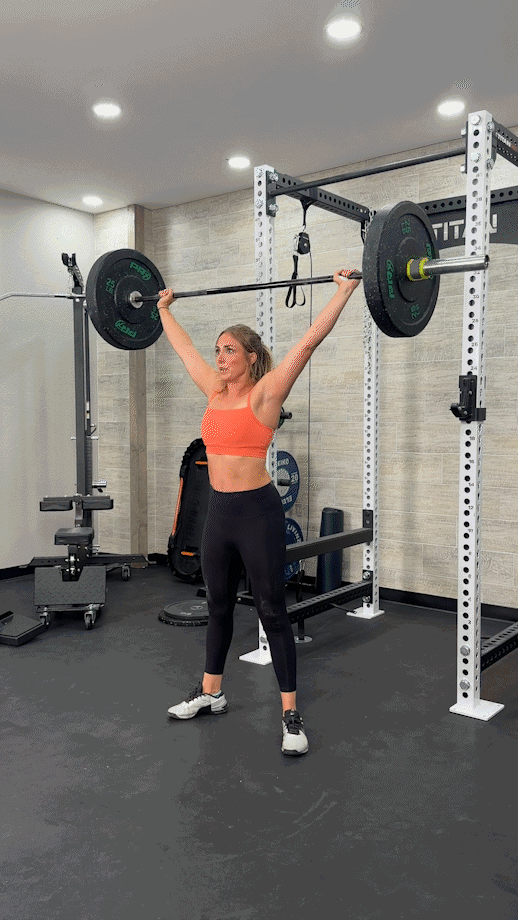
Zercher Squat
Benefits: During Zercher squats, the bar is at the front of your body and closer to your center of gravity. When you do back squats, you might feel pressure on your lower back because of where the bar sits. Zercher squats may help alleviate this pain, although you’ll likely need to reduce the weight on the bar.
How to do it:
- Adjust the J-hooks on a squat or power rack so the barbell is at hip height.
- Add the required weight plates.
- Step underneath the bar with your feet shoulder-width apart. You’ll want the barbell to rest in the crook of your elbows, and your hands should be in a closed-fist position, facing the ceiling.
- Stand up to unrack the bar, then take a couple of steps backward.
- Lift your chest up and activate your core.
- Squat down until your quads are at least parallel to the ground. Pause.
- Reverse the motion to return to the original position.
- Continue for reps before reracking the bar.
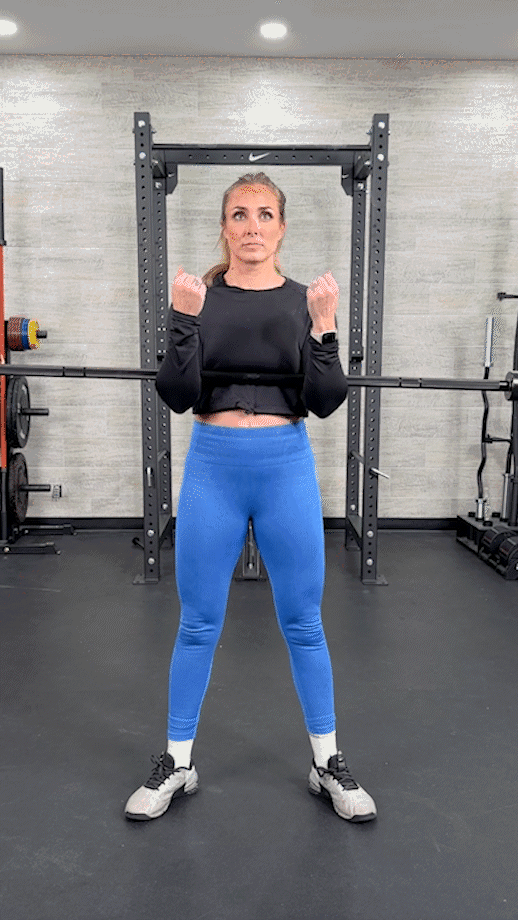
Pistol Squat
Benefits: Also known as single-leg squats, pistol squats engage each side of your body separately, helping fix muscular imbalances. You can do them anywhere, and a 2019 International Journal of Exercise Science5 study found that pistol squats may produce greater gluteus maximus activation compared to other squat variations.
How to do it:
- Stand tall with your feet shoulder-width apart.
- Lift your left foot off the floor and position your left leg in front of you. Your right foot should stay firmly planted on the ground.
- Brace your core, then lower yourself toward the floor by bending your right knee.
- Continue until your right thigh is parallel to the ground. Hold momentarily.
- Drive through your right heel to stand up.
- Keep going for reps, then replicate the exercise with your right leg in front of you.
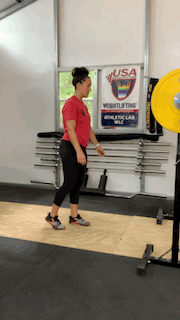
Jump Squat
Benefits: I love jump squats because they increase your heart rate while strengthening your lower body at the same time. You’ll often see them included in cardio or HIIT workouts. You can progress the exercise by holding a pair of dumbbells at your sides, and regularly doing them may help to improve your explosive strength.
RELATED: Explosive Workouts
How to do it:
- Stand upright with your feet hip-width apart. Your arms should be by your sides, in front of you, or across your chest.
- Squeeze your glutes and activate your core.
- Lower your body into the squat position, going as deep as possible with proper form.
- Drive your heels into the ground and explode upward to jump off the ground. Aim to get at least a couple of inches off the floor, if not more.
- Land softly with both feet, then adjust if necessary.
- Continue to jump squat for repetitions.
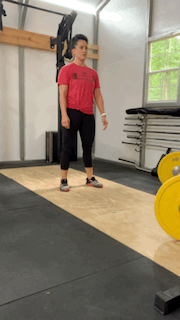
Cossack Squat
Benefits: Cossack squats have a different plane of movement compared to back squats. Back squats involve a front-to-back movement, whereas Cossack squats utilize a side-to-side movement. This results in a different type of muscle activation when performing Cossack squats. Additionally, it’s a unilateral exercise, helping to correct muscular imbalances.
How to do it:
- Stand tall with your feet wider than hip-width apart, similar to the plie squat described above. You’ll want your toes to be pointing outward.
- Brace your core and lift your chest up.
- Shift your body weight to the left side and bend your left knee to squat down. Your right leg should remain straight, and you’ll want to drive your hips backward.
- Continue until your left quad is almost parallel to the ground. Pause, then reverse the motion to return to your original position.
- Repeat for the desired number of reps before switching to the opposite side.
Expert tip: There are two ways to do Cossack squats. One way involves keeping both feet on the floor throughout the exercise. On the other, one foot (the opposite one to where your knee is bending) rotates up so the heel stays on the ground. Try both to see what you prefer—I enjoy the latter version.
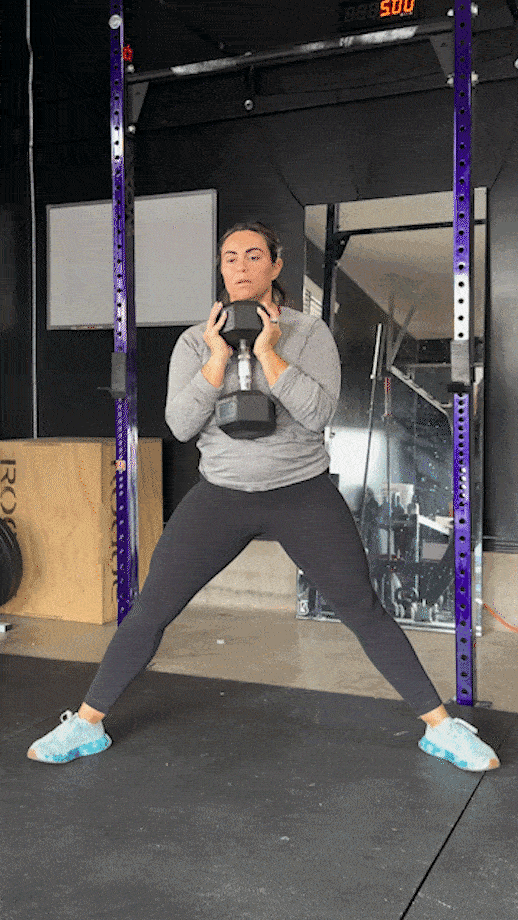
Hack Squat
Benefits: There are different types of hack squats, and some gyms may even have a dedicated machine. The benefit of hack squats over traditional squats is that they activate the quads to a greater extent. It’s worth noting that the other lower body muscles (glutes, hamstrings, and hip adductors) are engaged less during hack squats than back squats.
How to do it:
- Place a loaded barbell on the ground.
- Stand in front of the bar with your feet hip-width apart. You’ll want the bar to be touching your calves.
- Retract your shoulder blades, then squat down to get closer to the bar.
- Grasp the bar with an overhand grip (palms facing the floor) or mixed grip, and engage your core. Your hands should be outside of your legs.
- Drive through your feet to lift the bar toward your butt, squeezing your glutes at the top.
- Lower the bar to the floor slowly, keeping it close to your body (similar to how you would with a deadlift).
- Keep going for reps.
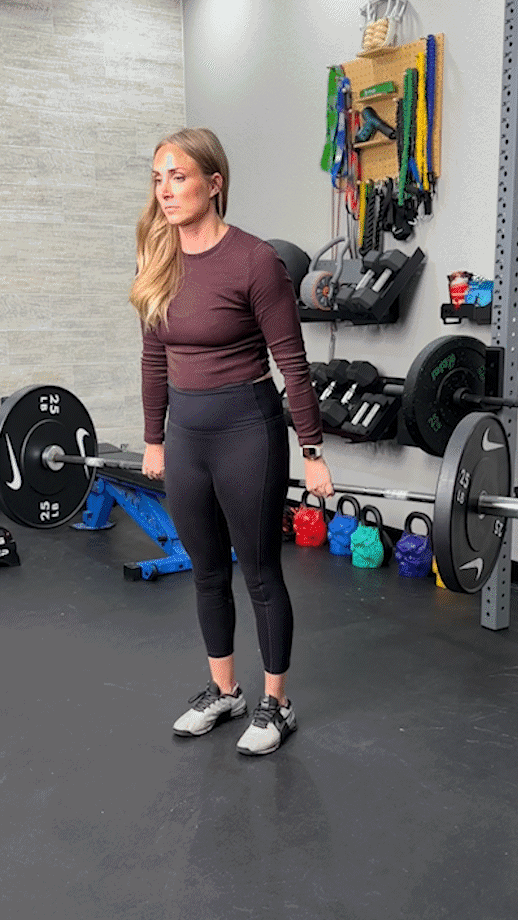
Landmine Squat
Benefits: A 2021 Journal of Strength and Conditioning Research6 study found that landmine squats “May be useful to balance hamstring to quadriceps activity, increase horizontal loading, and reduce vertical loading.” The starting position for landmine squats is slightly different from regular squats, which may be easier for beginners or inexperienced lifters.
How to do it:
- Secure a barbell in a landmine base, then add your desired weight plates.
- Stand upright next to the end of the bar, facing the landmine attachment. You’ll want your feet to be shoulder-width apart.
- Squat down to take hold of the bar, and bring it to the starting position. You should be standing tall with the bar at chest height.
- Squeeze your glutes and engage your core.
- Perform a squat to at least parallel, but if you can, go even lower.
- Hold momentarily, then drive through both heels to stand up.
- Squat for reps before placing the bar back onto the floor.
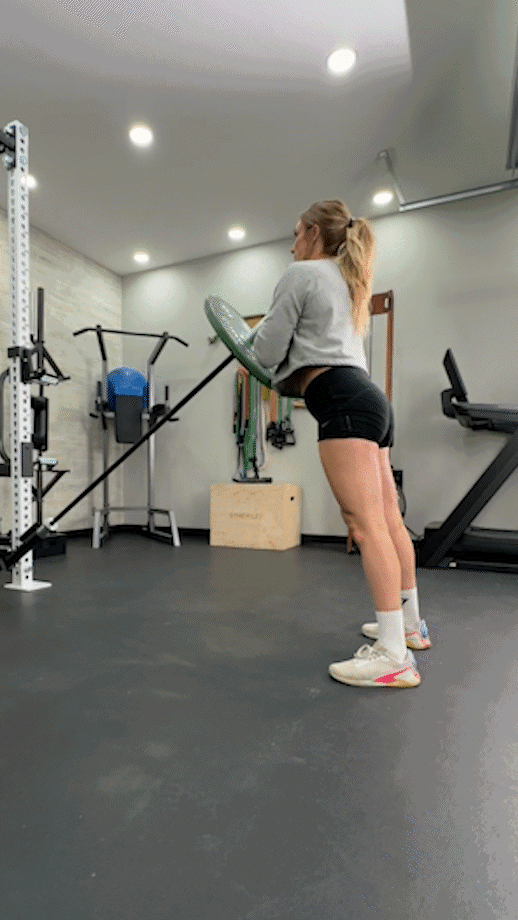
Smith Machine Squat
Benefits: The Smith machine is a less daunting piece of equipment than the squat or power rack, explaining why some choose it for squats. A 2009 Journal of Strength and Conditioning Research7 randomized controlled trial found that except for the gastrocnemius, biceps femoris, and vastus medialis, there were no significant differences between free weight and Smith machine squats.
How to do it:
- Set a Smith machine to roughly shoulder height, then add the desired amount of weight to both sides.
- Step underneath the Smith machine, similar to how you would a bar squat. You’ll want your feet to be hip-width apart, and you should hold the bar just outside of your shoulders.
- Unrack the Smith machine by standing up and twisting your wrists slightly.
- Activate your core and keep your head neutral.
- Squat down as though you were sitting on a chair. Keep going at least parallel.
- Stand back up by pushing through your heels.
- Continue for repetitions before reracking the Smith machine bar.
Expert tip: Although I’ve described Smith machine back squats above, there are other squat variations on this list that you can also do with a Smith machine. Examples include but are not limited to, front squats, split squats, and Bulgarian split squats.
RELATED: Smith Machine Leg Workouts
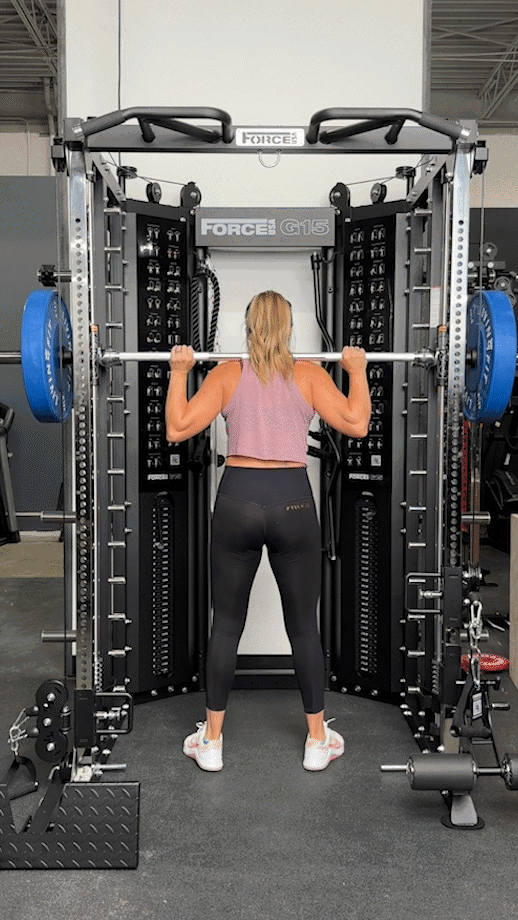
Anderson Squat
Benefits: Because you start Anderson squats from a dead stop, you’ll improve your explosive lower-body strength by doing them. You may also improve your hip mobility, which can help with other squat variations on this list. My clients have found their deadlifts are easier after adding Anderson squats to their workout routine.
How to do it:
- Set the safety bars on a squat or power rack to the bottom position of your squat (this will be at roughly hip height).
- Place an Olympic bar on top and load it to your required weight.
- Step underneath the bar. Your feet should be hip-width apart and you should be holding the bar just outside of your shoulders.
- Brace your core, then drive through your feet to stand tall. Pause momentarily.
- Bring the bar back down toward the safety bars slowly, ensuring that it comes to a dead stop.
- Repeat for reps.
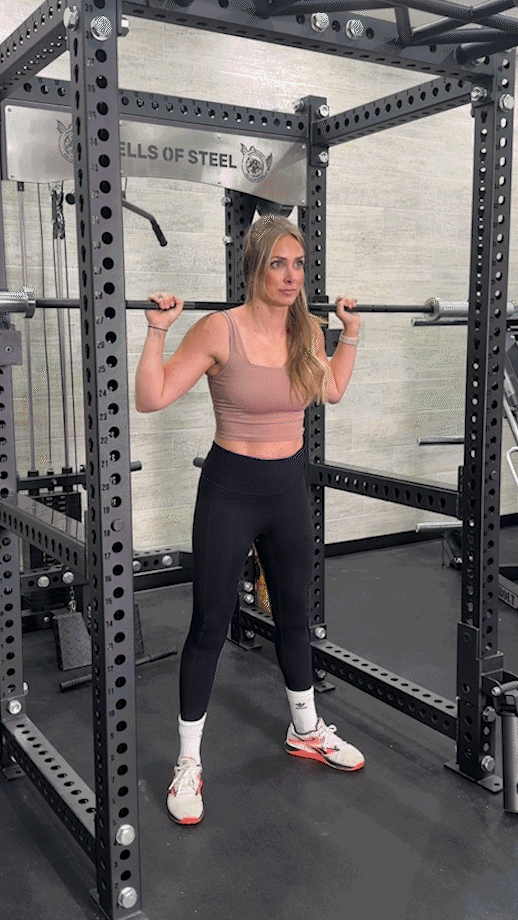
Chair Squat
Benefits: We included chair squats in our list of in-chair exercises, and for good reason. It’s similar to a box squat, but you don’t use a barbell or sit on the equipment. If you’re unable to reach parallel with a bodyweight squat or any other squat variation, chair squats are easier because of the slightly shorter range of motion (ROM).
How to do it:
- Stand tall in front of a chair. You’ll want to be facing away from it, with your feet shoulder-width apart.
- Position your arms by your sides, in front of you, or across your chest.
- Lift your chest up and engage your core.
- Squat down toward the seat of your chair.
- Lightly touch the seat with your butt, but don’t sit down.
- Reverse the motion by pushing through your feet, quads, hamstrings, and glutes.
- Continue for repetitions.
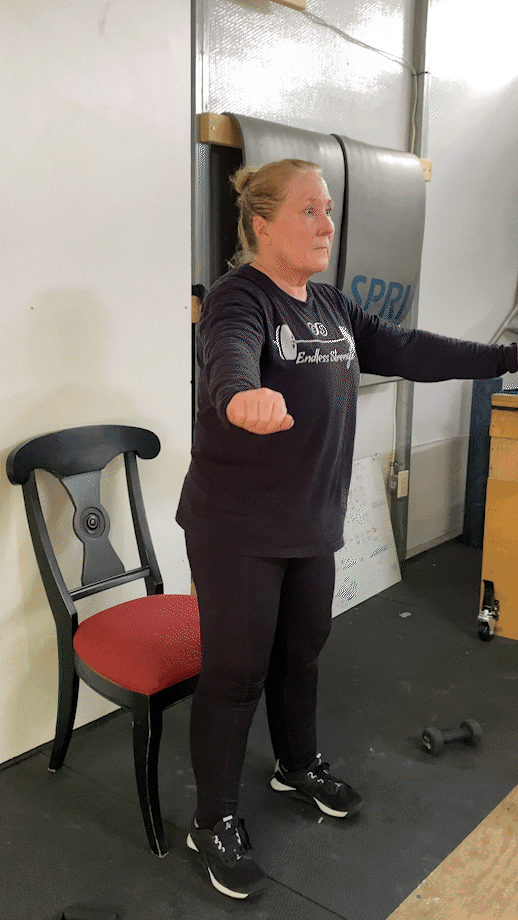
Sample Squat Variations Workouts
Now that I’ve shared the 21 best squat variations and how to do each step-by-step, you’ll need to know how to combine them into a complete workout. Here are three squat variations workouts—one for beginners, one for hypertrophy, and one for strength:
Squat Variations Workout For Beginners
For beginners, I’ve selected four exercises for a total of 10 sets. They’re all bodyweight exercises, so if any of them become too easy, add resistance in the form of dumbbells, kettlebells, resistance bands, or anything else you can find. For example, replace bodyweight squats with band squats or goblet squats. Rest for roughly 45 to 60 seconds between each set.
Before starting, warm up by doing a few minutes of cardio, then do lower-body dynamic exercises such as leg swings, lunges, jumping jacks, high knees, and more.
| Exercise | Sets | Reps |
| Bodyweight Squat | 3 | 10 |
| Plie Squat | 3 | 10 |
| Cossack Squat | 2 | 8, each side |
| Wall Squat | 2 | Hold for as long as possible |
Equipment needed: None
RELATED: At-Home Bodyweight Workouts
Squat Variations Workout For Hypertrophy
Increase your number of exercises and sets to build muscle (aka hypertrophy). The exercises will be more intense than those seen above because instead of training with just your body weight, you’ll also use barbells and weight plates. For this reason, you should rest between one and two minutes between each set.
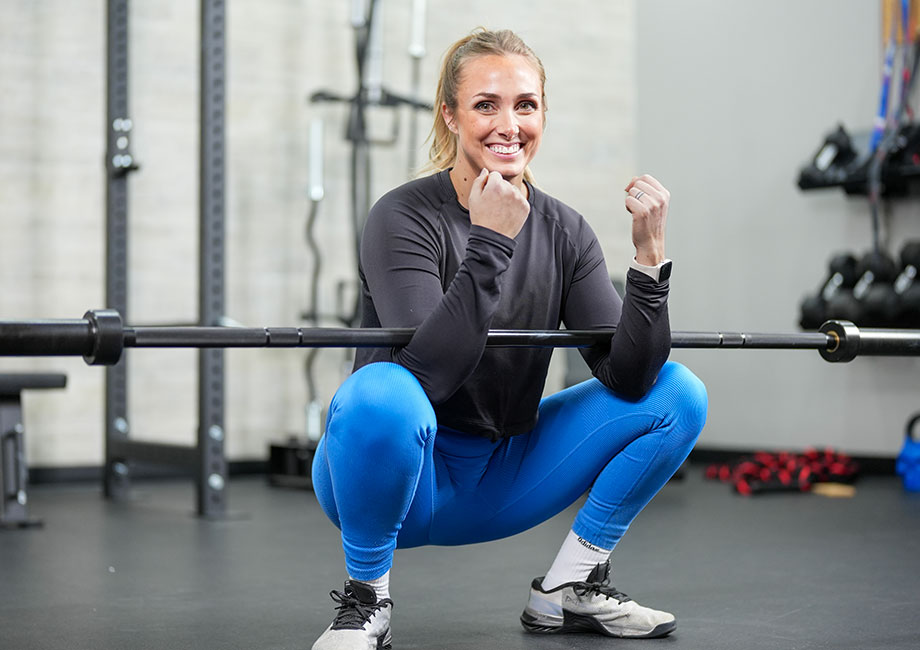
It’s important to perform lighter sets on the first two exercises before lifting heavier weights. Otherwise, warm up with a few minutes of cardio followed by lower-body dynamic exercises.
| Exercise | Sets | Reps |
| Pause Squat | 4 | 6 |
| Zercher Squat | 3 | 8 |
| Bulgarian Split Squat | 3 | 10, each side |
| Pistol Squat | 3 | 10, each side |
| Jump Squat | 2 | AMRAP* |
*As many reps as possible
Equipment needed: A squat or power rack, a barbell and weight plates, and a flat bench or plyometric box
Squat Variations Workout For Strength
The optimal number of reps to build muscle is between six and 12. For strength gains, however, you’ll be doing sets of five reps because this allows you to lift heavier weights (between 80% and 90% of your one-rep maximum). You’ll need at least two minutes of rest between sets, but don’t be afraid to take more if you need it to recover fully.
Perform a similar warm-up to what you’ve seen above (a few minutes of cardio and some dynamic exercises). You’ll also need to do some lighter sets on all the exercises listed below before your working sets.
| Exercise | Sets | Reps |
| Anderson Squat | 3 | 5 |
| Overhead Squat | 3 | 5 |
| Front Squat | 3 | 5 |
| Hack Squat | 3 | 5 |
Equipment needed: A squat or power rack, and a barbell and weight plates
Benefits of Squat Variations
There are many benefits of squats, so why should you consider squat variations? Certain squat variations are easier for beginners, may reduce knee and lower back pain, and can be useful to know when the correct equipment isn’t available. See below:
Easier For Beginners and Inexperienced Lifters
When you’re a strength training beginner, using a squat or power rack, a barbell, and weight plates can be intimidating. Even if you’re confident with this equipment, mastering proper form on regular squats is difficult. Squat variations such as bodyweight squats, band squats, Smith machine squats, and goblet squats are easier to learn for inexperienced lifters. You can then progress to barbell squats when the time is right.
RELATED: 7 Types of Strength Training
May Help Reduce Knee and Lower Back Pain
If you have pre-existing knee or lower back pain, regular squats might not be your best exercise. As a certified personal trainer (CPT), I’ve worked with clients where, no matter how much we work on their form, they still feel pressure on their knees. As soon as we switch to an alternative exercise (usually front squats or goblet squats), the pain disappears.
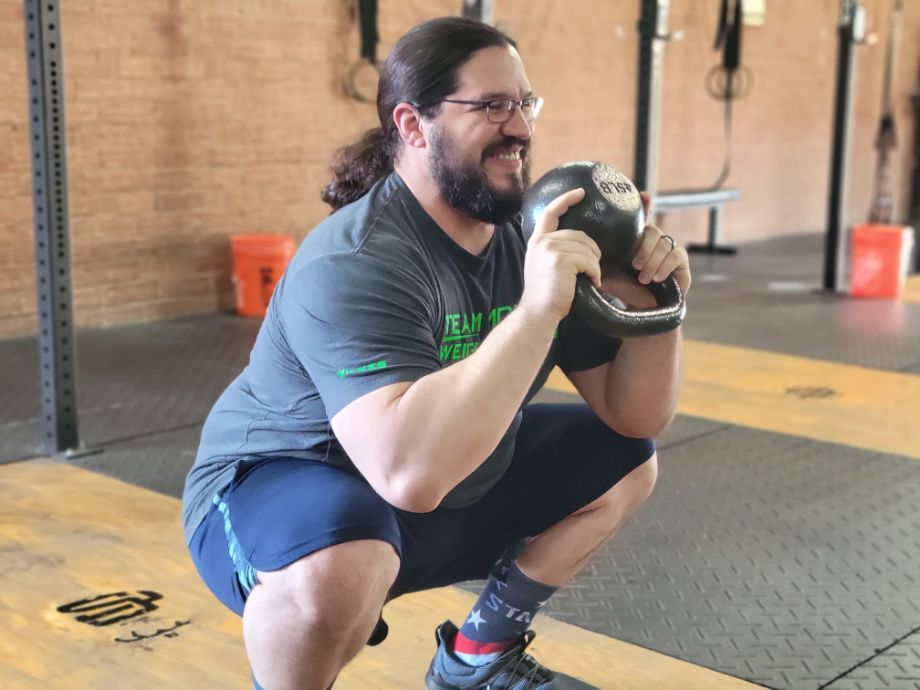
Great When Equipment Isn’t Available
Likely, you won’t always have a squat rack and a barbell available. If you train at a gym, there may be busy times when everything you want is in use. Alternatively, you may want to exercise at home or on vacation, and the equipment available is limited. This is where knowing the squat variations is useful—you can still hit your leg muscles without doing traditional barbell back squats.
Squat Variations: Final Thoughts
Since I started weight training 10 years ago, I’ve always had some type of squats in my routine. Admittedly, I’m a big fan of back squats and regularly do them. However, sometimes, the equipment I need isn’t available, and there was a period in my life when squats were causing my knees a lot of discomfort. This is when I started implementing squat variations into my workouts.
By now, I’m hoping that you know the 21 best squat variations and how to do them with the correct form. Of course, you’re not going to enjoy all of them, so it’s worth trying as many variations as you can to find the three or four that work for you. Once you do, perform them consistently to build strength and size in your lower body.
Squat Variations: FAQs
What squat variation is best?
There isn’t one single best squat variation. Examples of squat variations that I recommend to my personal training clients include:
– Bodyweight squat
– Wall squat
– Pause squat
– Band squat
– Split squat
– Bulgarian split squat
– Front squat
– Goblet squat
– Plie squat
– Box squat
– Sissy squat
– Overhead squat
– Zercher squat
– Pistol squat
– Jump squat
– Cossack squat
– Hack squat
– Landmine squat
– Smith machine squat
– Anderson squat
– Chair squat
The best squat exercise for you will depend on several factors, including how long you’ve been training, your fitness goals, whether you have any injuries, the equipment available, and more. I enjoy Bulgarian split squats, jump squats, front squats, and hack squats.
Which squat is easier on the knees?
If regular squats are tough on your knees, I’d suggest trying out the best knee sleeves first to see if they make a difference. For me, they’ve worked wonders when it comes to reducing my knee pain during back squats.
Alternatively, try front squats, Zercher squats, goblet squats, and box squats. The first three exercises start with the weight at the front of your body, which can put less pressure on the knees. With box squats, you won’t squat as deep, which also may be easier on your knees.
What is the 10 7 3 1 squat workout?
Let’s say that you’re doing the 10 7 3 1 squat workout with traditional back squats. You’ll do 10 reps of squats, followed by 10 seconds of rest. Next, you’ll do seven reps with seven seconds of rest. After this, you’ll do three reps with three seconds of rest. Finally, you’ll do one rep to finish the round. In total, you’ll have performed 21 reps.
RELATED: 5-3-1 Workout
You’ll rest for a couple of minutes before going again. As you can see, the 10-7-3-1 squat workout is a circuit-style workout with minimal rest in between.
References
- Wilk M, Petr M, Krzysztofik M, Zajac A, Stastny P. Endocrine response to high intensity barbell squats performed with constant movement tempo and variable training volume. Neuro Endocrinol Lett. 2018 Oct;39(4):342-348. PMID: 30531700.
- Korak JA, Paquette MR, Fuller DK, Caputo JL, Coons JM. Effect of a rest-pause vs. traditional squat on electromyography and lifting volume in trained women. Eur J Appl Physiol. 2018 Jul;118(7):1309-1314. doi: 10.1007/s00421-018-3863-6. Epub 2018 Apr 11. PMID: 29644392.
- Škarabot J, Cronin N, Strojnik V, Avela J. Bilateral deficit in maximal force production. Eur J Appl Physiol. 2016 Dec;116(11-12):2057-2084. doi: 10.1007/s00421-016-3458-z. Epub 2016 Aug 31. PMID: 27582260.
- Gullett JC, Tillman MD, Gutierrez GM, Chow JW. A biomechanical comparison of back and front squats in healthy trained individuals. J Strength Cond Res. 2009 Jan;23(1):284-92. doi: 10.1519/JSC.0b013e31818546bb. PMID: 19002072.
- Knoll MG, Davidge M, Wraspir C, Korak JA. Comparisons of Single Leg Squat Variations on Lower Limb Muscle Activation and Center of Pressure Alterations. Int J Exerc Sci. 2019 Aug 1;12(1):950-959. PMID: 31523343; PMCID: PMC6719809.
- Collins KS, Klawitter LA, Waldera RW, Mahoney SJ, Christensen BK. Differences in Muscle Activity and Kinetics Between the Goblet Squat and Landmine Squat in Men and Women. J Strength Cond Res. 2021 Oct 1;35(10):2661-2668. doi: 10.1519/JSC.0000000000004094. PMID: 34341315.
- Schwanbeck S, Chilibeck PD, Binsted G. A comparison of free weight squat to Smith machine squat using electromyography. J Strength Cond Res. 2009 Dec;23(9):2588-91. doi: 10.1519/JSC.0b013e3181b1b181. PMID: 19855308.


